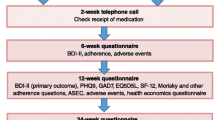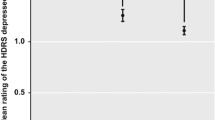Abstract
Depression is present in about 40% of patients with dementia. Whereas most studies of depression in dementia are carried out in patients with Alzheimer’s dementia, depression is also a frequent finding in other types of dementia, such as ischaemic vascular dementia, dementia with Lewy bodies and fronto-temporal dementia. Longitudinal studies have demonstrated that untreated major depressions may last for more than 1 year in patients with dementia, whereas minor depression is of shorter duration. Despite the high incidence of depression in patients with dementia, few controlled studies have examined the usefulness of antidepressant drugs. Tricyclic antidepressants (TCAs) such as imipramine and clomipramine may be effective, but a high incidence of adverse effects such as orthostatic hypotension and urinary retention may limit their use to the subgroup of patients in whom tolerability is acceptable. Selective serotonin (5-hydroxy-tryptamine; 5-HT) reuptake inhibitors (SSRIs) such as citalopram and fluoxetine have efficacy similar to that of TCAs, but the incidence of adverse effects is substantially lower. Monoamine oxidase inhibitors have rarely been assessed in patients with dementia, although moclobemide has demonstrated good efficacy and tolerability in a single study. Although antidepressant drugs usually demonstrated greater efficacy than placebo, these differences were mostly slight and require further evaluation.
Similar content being viewed by others
References
American Psychiatric Association. Diagnostic and Statistical Manual of Mental Disorders. 4th ed. Washington, DC: American Psychiatric Association, 1994
Evans DA, Funkenstein H, Albert M, et al. Prevalence of Alzheimer’s disease in a community population of older persons: higher than previous reported. JAMA 1989; 262: 2551–6
Lishman W, editor. Organic psychiatry. 3rd ed. Oxford: Blackwell Science, 1998
Price D, Thinakaran G, Borchelt D, et al. Neuropathology of Alzheimer’s disease and animal models. In: Markesbery W, editor. Neuropathology of dementing disorders. London: Arnold, 1998: 121–41
Chui HC. Dementia: a review emphasizing clinicopathologic correlation and brain behavior relationship. Arch Neurol 1989; 46: 806–14
Kosaka K, Yoshimura M, Ikeda K, et al. Diffuse type of Lewy body disease: progressive dementia with abundant cortical Lewy bodies and senile changes of varying degree-a new disease? Clin Neuropathol 1984; 3: 185–92
Perry R, Irving D, Blessed G, et al. Senile dementia of Lewy body type. A clinically and neuropathologically distinct type of Lewy body dementia in the elderly. J Neurol Sci 95: 119-39
Hansen L, Salmon D, Galasko D, et al. The Lewy body variant of Alzheimer’s: a clinical and pathologic entity. Neurology 1990; 40: 1–8
The Lund and Manchester Groups. Consensus statement. Clinical and neuropathological criteria for fronto-temporal dementia. J Neurol Neurosurg Psychiatry 1994; 4: 416–8
Klatka L, Louis E, Schiffer R. Psychiatric features in diffuse Lewy body disease. Neurology 1996; 47: 1148–52
Neary D, Snowden J, Gustafson L, et al. Frontotemporal lobar degeneration. A consensus on clinical diagnostic criteria. Neurology 1998; 51: 1546–54
Chemerinski E, Petracca G, Sabe L, et al. Specificity of depressive symptoms in Alzheimer’s disease. Am J Psychiatry. In press
Lyketsos C, Steele C, Galik E, et al. Physical aggression in dementia patients and its relationship to depression. Am J Psychiatry 1999; 156: 66–71
Cummings J, Miller B, Hill M, et al. Neuropsychiatric aspects of multi-infarct dementia and dementia of the Alzheimer type. Arch Neurol 1987; 44: 389–93
Lorek D, Folstein M. Depression in cerebrovascular disease. In: Starkstein S, Robinson R, editors. Depression in neurologic disease. Baltimore (MA): Johns Hopkins University Press, 1993
Migliorelli R, Teson A, Sabe L, et al. Prevalence and correlates of dysthymia and major depression among patients with Alzheimer disease. Am J Psychiatry 1995; 152: 37–44
Lyketsos C, Steel C, Galik E, et al. Major and minor depression in Alzheimer’s disease: prevalence and impact. J Neuropsychiatry Clin Neurosci 1997; 9: 556–61
Starkstein S, Sabe L, Vasquez S, et al. Neuropsychological, psychiatric, and cerebral blood flow findings in vascular dementia and Alzheimer’s disease. Stroke 1996; 27: 408–14
Levy M, Miller B, Cummings J, et al. Alzheimer disease and frontotemporal dementias. Arch Neurol 1996; 53: 687–90
Ballard C, Holmes C, McKeith I, et al. Psychiatric morbidity in dementia with Lewy bodies: a prospective clinical and neuropathological comparative study with Alzheimer disease. Am J Psychiatry 1999; 156: 1039–45
Berger A, Fratiglioni L, Forsell Y, et al. The occurrence of depressive symptoms in the preclinical phase of AD. Neurology 1999; 53: 1998–2002
Chen P, Ganguli M, Mulsant B, et al. The temporal relationship between depressive symptoms and dementia. Arch Gen Psychiatry 1999; 56: 261–6
Starkstein S, Chemerinski E, Sabe L, et al. Prospective longitudinal study of depression and anosognosia in Alzheimer’s disease. Br J Psychiatry 1997; 171: 47–52
Hope T, Keene J, Fairburn C, et al. Natural history of behavioral changes and psychiatric symptoms in Alzheimer’s disease. Br J Psychiatry 1999; 174: 39–44
Brodaty H, Luscombe G. Depression in persons with dementia. Int Psychogeriatr 1996; 8(4): 609–22
Pearlson G, Ross C, Lohr W, et al. Association between family history of affective disorder and the depressive syndrome of Alzheimer’s disease. Am J Psychiatry 1990; 147: 452–6
Lyketsos C, Tune L, Pearlson G, et al. Major depression in Alzheimer’s disease. An interaction between gender and family history. Psychosomatics 1996; 37: 380–4
Ott B, Lefleche G, Welihan W, et al. Impaired awareness of deficits in Alzheimer disease. Alzheimer Dis Assoc Disord 1996; 10: 68–76
Zweig R, Ross C, Hedreen J, et al. The neuropathology of aminergic nuclei in Alzheimer’s disease. Ann Neurol 1988; 24: 233–42
Zubenko G, Mossy J, Kopp U. Neurochemical correlates of major depression in primary dementia. Arch Neurol 1990; 47: 209–14
Hoogendijk W, Sommer I, Pool C, et al. Lack of association between depression and loss of neurons in the locus coeruleus in Alzheimer disease. Arch Gen Psychiatry 1999; 56: 45–51
American Psychiatric Association. Diagnostic and Statistical Manual of Mental Disorders. 3rd rev. ed. Washington, DC: American Psychiatric Association, 1987
Starkstein S, Vázquez S, Migliorelli R, et al. A SPECT study of depression in Alzheimer’s disease. Neuropsychiatry Neuropsychol Behav Neurol 1995; 8: 38–43
Hirono N, Mori E, Ishii K, et al. Frontal lobe hipometabolism and depression in Alzheimer’s disease. Neurology 1998; 50: 380–3
Pozzi D, Golimstok A, Migliorelli R, et al. Quantified EEG correlates of depression in Alzheimer’s disease. Biol Psychiatry 1993; 34: 286–91
Reifler B, Teri L, Raskind M, et al. Double blind trial of imipramine in AD patients with and without depression. Am J Psychiatry 1989; 146: 45–9
Fuchs A, Hehnke U, Erhart C, et al. Video rating analysis of effect of maprotiline in patients with dementia and depression. Pharmacopsychiatry 1993; 26: 37–41
Petracca G, Teson A, Chemerinsk E, et al. A double-blind placebo-controlled study of clomipramine in depressed patients with Alzheimer’s disease. J Neuropsychiatry Clin Neurosci 1996; 8: 270–5
Nyth A, Gottfries C. The clinical efficacy of citalopram in treatment of emotional disturbance in dementia disorders. A Nordic multicentre study. Br J Psychiatry 1990; 157: 894–901
Taragano F, Lyketsos C, Mangone C, et al. A double-blind, randomized, fixed-dose trial of fluoxetine vs amitriptyline in the treatment of major depression complicating Alzheimer’s disease. Psychosomatics 1997; 38: 246–52
Katona C, Hunter B, Bray J. A double-blind comparison of the efficacy and safety of paroxetine and imipramine in the treatment of depression with dementia. Int J Geriatr Psychiatry 1998; 13: 100–8
Roth M, Mountjoy R, Amrein R, and the International Collaborative Study Group. Moclobemide in elderly patients with cognitive decline and depression. Br J Psychiatry 1996; 168: 149–57
American Psychiatric Association. Diagnostic and Statistical Manual of Mental Disorders. 3rd ed. Washington, DC: American Psychiatric Association, 1980
Teri L, Logsdon R, Uomoto J, et al. Behavioral treatment of depression in dementia patients: a controlled clinical trial. J Gerontol B Psychol Sci Soc Sci 1997; 4: 159–66
Stoudemire A, Dessonville Hill C, Morris R, et al. Improvement in depression-related cognitive dysfunction following ECT. J Neuropsychiatry Clin Neurosci 1995; 7: 31–4
Nelson J, Rosenberg D. ECT treatment of demented elderly patients with major depression: a retrospective study of efficacy and safety. Convuls Ther 1991; 7: 157–65
Acknowledgements
This study was partially supported by grants from the Raul Carrea Institute of Neurological Research-FLENI, and the Fundación Perez Companc.
Author information
Authors and Affiliations
Corresponding author
Rights and permissions
About this article
Cite this article
Fridman, E.A., Starkstein, S.E. Treatment of Depression in Patients with Dementia. Mol Diag Ther 14, 191–201 (2000). https://doi.org/10.2165/00023210-200014030-00002
Published:
Issue Date:
DOI: https://doi.org/10.2165/00023210-200014030-00002




